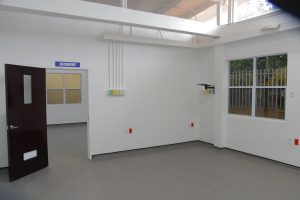— as works progress on two surgical theatres, new ICU and more
THE SMART upgrades on the Mabaruma Hospital in Region One, Barima Waini, are progressing nicely, with works slated to be completed by the end of August 2021, according to Health Minister, Dr. Frank Anthony.
The ‘SMART Hospital’ concept, as previously outlined, refers to a facility that is both safe and ‘green’ in its operations. The upgrades are being done as part of an $835M (US$4.175 million) project, funded by the United Kingdom Department for International Development (DFID); and encompasses four additional hospitals.
Speaking with the Guyana Chronicle on Sunday, Dr. Anthony explained that the project at Mabaruma, estimated to cost approximately US$800,000, will see the refurbished hospital boasting of a spanking new Accident and Emergency Department, a renovated recovery room, a state-of-the-art Intensive Care Unit (ICU), a refurbished kitchen, a sterilisation room, and, not one, but two surgical theatres, a small and a large one, Dr. Anthony posited.

He indicated, too, that once completed, the Mabaruma Hospital will also be outfitted with brand new equipment.
Outside of the scope of works of the SMART conversions project, Dr. Anthony said that the government has also invested in the construction of a new storage bond for the region’s pharmaceuticals. “The actual building has already been completed” and will become operational by next month, the Health Minister noted.
Added to that, Minister Anthony said that efforts were being made to ensure that the region not only has an adequate supply of medication and proper facilities, but also enough qualified medical practitioners.
To this end, Dr. Anthony said that construction has commenced on new living quarters for doctors who are being sent to work in the region. “Right now, they are doing the foundation for the building,” the Health Minister related.
He added that when the construction works are completed, “the Ministry of Health will deploy a surgeon to the region.” As it is, the Mabaruma district has general physicians, but no one specialised to conduct surgeries.
Minister Anthony had previously explained that the project to convert the five local hospitals is expected to wrap up by the end of the year. This means that, within the next few months, Guyana will boast of hospitals that are climate-resilient and energy efficient. Already, the Diamond Diagnostic Centre has been completed and recommissioned.
Dr. Anthony said that works on the Leonora Hospital, West Coast Demerara, are being ‘wrapped up’, and could see the hospital soon reopening at full capacity. Once the Leonora Hospital is completed, the Mabaruma Hospital is expected to follow, after which the Lethem Regional Hospital in Region Nine and the Paramakatoi Health Centre in Region Eight will come on stream.
When the project concludes, the hospitals will have the requisite infrastructure to guard against flooding, as well as the capacity to garner renewable energy, thereby reducing the reliance on the Guyana Power and Light (GPL); the hospitals would also be conserving all of its resources, including water, as the hospitals will all be able to use rainwater for their day-to-day functions.
Dr. Anthony had said that the upgrading of hospitals reduces the public’s reliance on the Georgetown Public Hospital Corporation for key services such as surgeries and x-rays.
FIGHT AGAINST CLIMATE CHANGE
Moreover, Dr. Anthony said that the conversions of these local hospitals are directly linked to the government’s fight against climate change, having recognised the detrimental impact that poor environmental practices have had and continue to have on human health.
Dr. Anthony had previously noted that within the next few years, the People’s Progressive Party/Civic (PPP/C) will be looking to convert all the health facilities in Guyana. “We have already done the assessment of 89 other health facilities,” the minister posited.
Previously, in explaining the importance of the SMART hospital project, Dr. Anthony made specific reference to reports released by the United Nations’ Inter-Governmental Panel on Climate Change (IPCC), particularly as it relates to the notable rise in global temperatures.
“For the last hundred years, the earth’s temperature has increased by 0.75 degrees Celsius and every decade since 1850, we are living in warmer climate,” the minister said, pointing to the consequences of Guyana’s infamous 2005 floods.
In a series of articles published in January, the Guyana Chronicle examined a number of adverse effects that climate change is likely to have on local sectors, including sea defence, health and food production, all due to the projected rise in sea levels.
As a matter of fact, the IPCC predicts that “global warming will worsen human health conditions, especially in tropical regions”. In countries such as Guyana, an increase in temperature indicates an increase in mosquito population, thereby escalating the risk of a variety of insect-borne infections.
“… and those mosquitos would bring with them, a number of different types of disease such as dengue and malaria, and chikungunya, and so forth,” Dr. Anthony related.
In addition to vector-borne and water-borne diseases, global warming also paves the way for increased heat waves, which would result in prolonged periods of abnormally high temperatures that can have serious health effects on vulnerable populations, such as the elderly and the sick.
“This was already seen during the 2003 heat wave in Europe, which claimed approximately 35,000 lives,” a recent UN Climate Change report indicated.
In a previous article, Guyanese Scientist, Dr. Michelle Kalamandeen had told the Guyana Chronicle that climate change has inevitably created the deadly monster that is the novel coronavirus. She explained that three out of every four new infectious diseases in people come from animals. “More specifically, from our wildlife and from the livestock we keep in ever-increasing
numbers… if an area becomes too hot or too cold for certain wildlife, they will migrate to new places, where they interact with other animals that they have never encountered before,” Dr. Kalamandeen had explained. She reasoned that this usually results in humans increasingly sharing the same spaces and vying for the same food as various species of organisms, thereby increasing the risk of transmission of diseases from animals to humans. The Health Minister had also indicated his ministry’s efforts to craft a comprehensive 10-year strategic plan which seeks to examine a plethora of ways that his ministry can respond to climate change. “… and our preparedness in terms of health response to things like pandemics and flooding and so forth… we want to ensure that we build that capacity to respond to [the] effects of climate change, and try to make our systems more climate-resilient,” Dr Anthony asserted.












